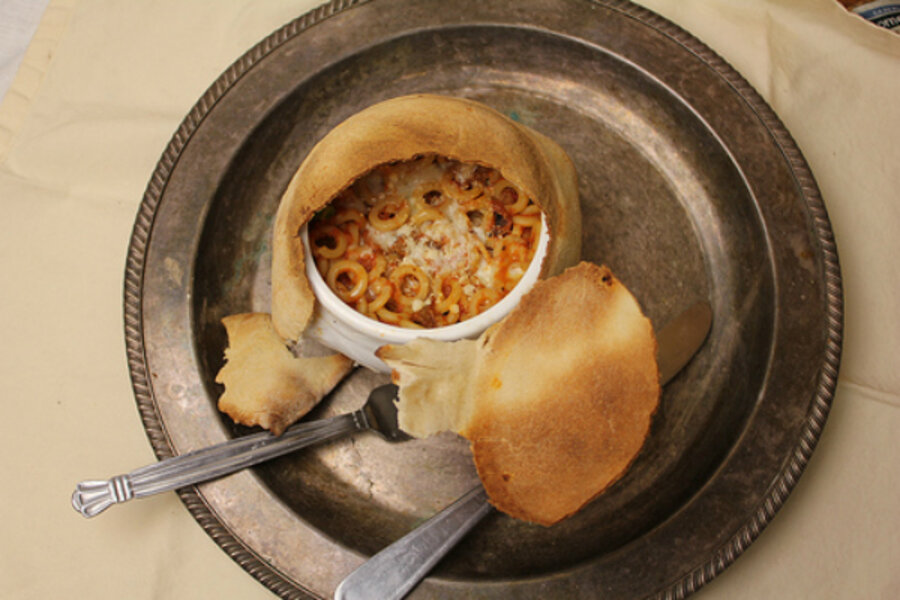Scilian pasta pie (aneletti alla Palermitana)
Loading...
“To have seen Italy without having seen Sicily is to not have seen Italy at all, for Sicily is the clue to everything.”
- Johann Wolfgang von Goethe
Sicily sits apart from mainland Italy, like a rock ready to receive a swift kick from the instep of the Italian boot. Indeed, many Italians would tell you that this is precisely what the unruly, volcanic island needs. Throughout its diverse and textured history, Sicily has always been set apart somehow, having been in turn either at the very center of things or at their very periphery. Perhaps this wild oscillation of stature has had as much of an influence on the outlook and behavior of the Sicilians, their dialects and cuisine, as the people and cultures that have passed through the island over the past two-and-a-half millennia.
An enduring legacy of these historical ups and downs and comings and goings is the widely known phenomenon of disagreement: Ask two Sicilians a question and you’ll get at least three conflicting opinions, regardless of subject. It is possible that in this lie the origins of the island’s infamous culture of vendetta but, as we’ve previously noted – in relation to the composition of one of the island’s most famous pasta dishes, intense disagreement is also present at the Sicilian table. It was little surprise then, to find a similar level of disagreement among recipes for aneletti alla Palermitana – a hearty pasta and vegetable pie.
Palermo, is Sicily’s capital and largest city, and has an international reputation as a locus for street food. The swordfish spiedini, various fried seafoods, stewed spleen rolls, and chickpea fritter sandwiches, are the stuff of gastronomic legend. Palermo, however, also has its very own set of dishes meant for the table, among them pork chops (cotolette) dusted with breadcrumbs and capers before being fried; and whole fish (often orata, sea bream), baked and served, alla Palermitana, with capers, olives, tomatoes, and lemon. The ratios in this latter dish – and indeed whether it is baked versus grilled and served with a sauce of the vegetables or simply sprinkled with uncooked vegetables – is a matter of much debate. The same is true of aneletti alla Palermitana and its close cousin aneletti al forno.
Unlike its alla Palermitana compadres, these dishes don’t call for capers or olives or lemon, what is uniquely Palermitana here is the aneletti, a pasta only found in and around Palermo. There is at least basic agreement that the dishes should contain a meat sauce, aneletti pasta and peas, but that’s more or less where the concord ends. (We should note, parenthetically, that there are versions for mid-summer and mid-winter, in which most of the festival versions sub salami for ground meat). Most recipes call for eggplant, some eschew it; some insist on three kinds of melting cheese (any of provola, caciocavallo, scamorza, primosale and fontinella), which may or may not be mixed in with the sauce and pasta depending on whose grandma made it; others only one kind of cheese; some decree that it must be formed into a timbale (often wrapped in strips of eggplant) and served in slices like a cake at room temperature, others that it be topped with breadcrumbs and served gooey from a baking dish.
Not having enjoyed the dish in Sicily yet, the only version of the dish we’ve eaten – at Cacio e Vino restaurant in New York City – doesn’t match any of those we can find online, and could well be their imaginative, chefy take on the variety of preparations. Preferring not to mix the cheese and, instead, place it on the bottom of the baking dish and leaving out eggplant, Cacio e Vino tops theirs with a buttered hat of pizza dough baked to a chewy crust, resembling a beret, as the cheese melts inside.
Aneletti, also written anelletti, (meaning “little rings”) is a traditional Sicilian style of flat, circle-shaped pasta, just about big enough to wear on the tip of your pinky finger, and not unlike American Spaghetti-Os in appearance. Surprisingly, given how familiar and how much fun they are to eat, they aren’t easy to find in the United States, even in specialty Italian grocers and online. We first made this dish a couple of years ago while we lived in Brooklyn and, having come up short after searching high and low for them in as many Italian stores as that borough has, we ordered some aneletti online. We've been working our way through the 10-lb. box ever since.
So it was recently, that when doing a bit of pantry spring cleaning, we unearthed our remaining 8 lbs., and, as coincidences go, also happened to have a pound of Sunday gravy in the freezer and some pizza dough leftover from the season’s first pizzas on the grill. It seemed a propitious moment to get all Sicilian.
Sure enough, while we all wiped our plates clean with the last scraps of the pizza dough, a general disagreement broke out over whether our version would have been better with eggplant and/or breadcrumbs, and whether our choice of caciocavallo over the more highly smoked scamorza was the right decision, and if not, whether that would have improved or obscured the overall flavor. Happily, we’ve still got 7 lbs. of aneletti left with which to work through most of the remaining untried combinations.
Aneletti alla Palermitana
serves 4-6 hungry people
1lb. aneletti
1lb. meat sauce/gravy
1lb. pizza dough
1/2 caciocavallo cheese or your choice of sharp provolone, scamorza, smoked mozzarella, primosale or fontanella
2 handfuls frozen peas
4-6 generous tablespoons of grated pecorino
2 tablespoons melted butter
1. Pre-heat oven to 500F/240C
2. Cook pasta in abundantly salted water until just al dente, no more. Drain.
3. In a separate saucepan, heat your meat sauce until hot and mix cooked pasta in until coated and well-combined.
4. In a large earthenware pot, deep casserole or enameled Le Creuset-type pot, place thin slices or handfuls of grated caciocavallo (or your choice of melting cheese, see above)
5. Spoon or carefully pour pasta and meat sauce on top, sprinkling liberally with peas.
6. Next, sprinkle mixture generously with grated pecorino.
7. On a floured surface, roll-out pizza dough and stretch it over your pot making sure to seal it tightly around the edges.
8. Brush liberally with melted butter (or olive oil, if preferred), and place in hot oven.
9. Bake until top is nicely crispy, 5-12 minutes, depending on size and make of oven.
10. Serve immediately, table-side, with a flourish as you pull back the pizza dough and release clouds of mouth-watering steam.
11. Each person should get both pasta and pizza crust. The crust is as ideal a conveyance for the pasta to the mouth as it is useful for wiping the plate clean at the end.








